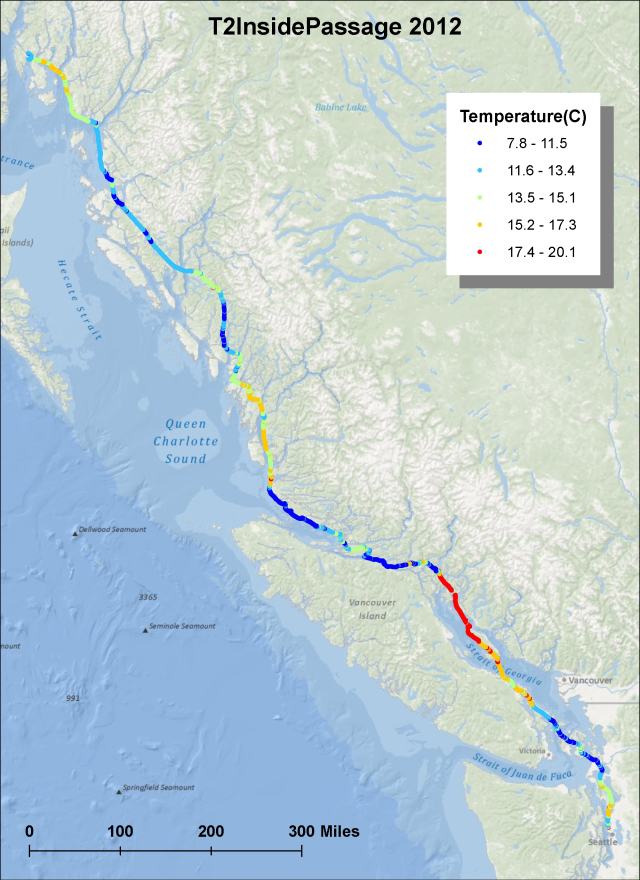It was a cold, cold 15 minutes of attempting to stay in Lake Washington. No dry suit; just swim suit.
Category: Science
SO FOR R2AK – Scientific Observations for Oceanographic Research Race to Alaska
What’s going on?! Is it last week’s record rainfalls, the crazy northwesterly that blew through on their tail, the minor earthquake recorded off Vancouver Island last month, or is the Salish Sea finally just fed up?
What I see ahead reminds me of the Smirnoff ad that Roz Savage www.rozsavage.com posted a link to on her blog a few years ago: a deckhand throws his empty beer can over the ship’s rail and Neptune revolts, lifting all the trash and sunken ships and planes of the ages off the bottom and throwing it all back up to where it came from.
The waters ahead are littered with logs, a tree with its roots intact, what looks like the remains of someone’s picnic picked up by a wave mid event and reset at sea and a clump of kelp with a large block of polystyrene foam trapped in the middle. Two gulls are perched on it eying each other as the foam bobs along with the current. All this in a ragged line playing off to the northeast.
The wind, on our port quarter, pushes us rapidly towards this barrier. How do I get through? Half an hour ago we had to stop to free a plastic shopping bag from our rudder. Our speed dropped precipitously from 21 kph to seven as the bag hooked the rudder’s heel and then opened like a sea anchor set by the Pardey’s. I yell to Scott who is dozing off shift “trash line!” He jumps up and is up the mast in seconds gazing out like an Arctic ice spotter looking for a way through. “It’s bad” he yells, “really bad!”
I don’t want to get stuck, I think, recalling a recent night sail with my friend Andy that put us and my boat Tsunamichaser, in a massive raft of trash and debris from which it took over an hour to extract ourselves as we drifted towards the breakers on the eastside of Lopez Island. Or the two days my girlfriend and I spent extracting our Westsail 28 from the sea vegetable and leftover detritus soup that trapped us in the hurricane hole off Winter Harbour up Vancouver Island’s west coast years ago.
The added weight of Scott aloft sends a slug of seawater over the deck and into my face. Wow that water is warm, I think. I look at our seawater temperature read out; 18.3c. We have been continuously logging sea temperatures since leaving Port Townsend three days ago. A degree higher than the temperatures that Traci C and Tracy L recorded on their passage to Ketchikan in 2012 but not as warm as our fellow sailors Mike and Catherine documented last summer off Lund.

http://t2can.wordpress.com/
“How are we going to get through?” I yell back.
“Tack” Scott yells. “Tack NOW!”
Tiller over hard, we go through decks level, the sail momentarily shakes as the pressure eases and then the snotter comes tight on our Pacific rig as we take off on a new course. There!, I see the gap Scott has seen. Between an up surging boil full of life and nutrients and the adjacent spinning tangle of debris – a clean line. I drop in like a surfer in the right spot on the perfect wave who with two quick strokes takes off down the waves face. Like the same surfer entering “the green room” my hand momentarily trails in the water – cold shock! A quick look at the temperature readout confirms the change, it’s 6c.
“Thermocline!” I yell. “It was all because of a massive thermocline!”
I’m reminded of how hard science can be. What we observe right now might not be what we think it is. We get to circle the sun a limited number of times in our life, yet the cycles of life are long and ever changing. Is it safe to draw any conclusion? Even after a lifetime of observation? Where I sail right now there was once a thick sheet of ice. What would I think if I woke tomorrow to that! The land has changed. We humans have always had an effect on the landscape but are we bigger than the Pico de Fogo volcano that is reshaping Cape Verde today? What about a streaking meteorite colliding with our planet. One day it’s like it has always has been the next very different. If we knew it was coming what could we do? A thousand years ago we would have looked skywards in awe of the light that wasn’t supposed to be there. But it’s the slow incipient change that we have wrought over the last few (insert ten, hundred or thousand – your choice) years that might matter now. Many small unmeasurable changes hurling us towards a tipping point.
For the moment, Scott and I sail on. The wind blows from the northwest. The others are out there somewhere. After all there’s a race on and we are bearing down on our competition as the winds change to our advantage.